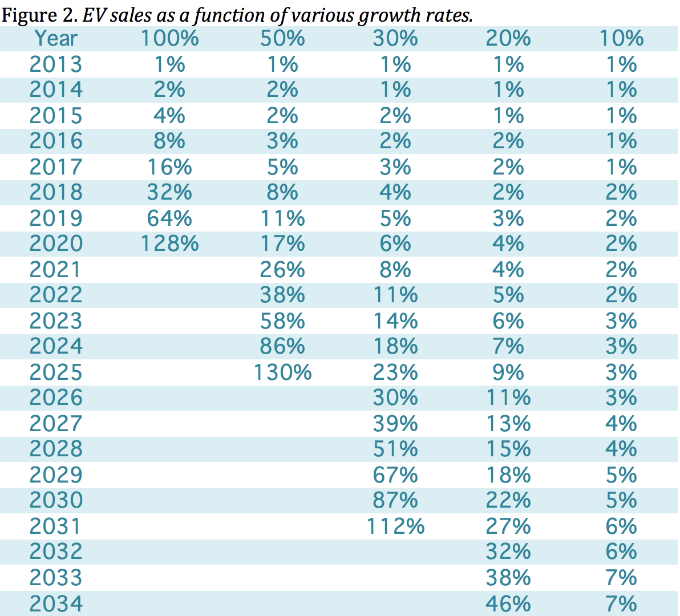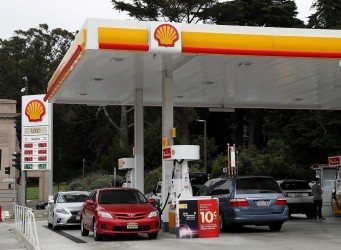I have been saying for years now that electric vehicles will take over the market sooner rather than later. And that it will be much, much sooner than almost anyone else predicts.
At 2012’s University of Chicago Booth School of Management spring Conference I listened to the Keynote Panel discuss The Future of Transportation. The panelists were Bill Reinert, National Manager Advanced Technology Group, Toyota Motor Sales and Michael Wirth, EVP, Downstream and Chemical, Chevron Corp. I was surprised to hear them agree that only a small percentage of cars and light duty trucks would be electric by midcentury!! They said, as I recall, that it would be something like 20% and that these would be mostly hybrids. They may be the “experts” but I believe they’re mistaken.
Call me disillusioned or crazy but I predict that by the end of THIS decade you’ll see consumers shifting dramatically to electric vehicles. And while some of these vehicles may have gas engine backups most won’t. And even if they do, the electric fleet will be driving over 80% on electricity, maybe even over 90%. With just 30 to 40 miles of electrical range in my current Volt, I’m driving over 75% on electricity.
Be a skeptic if you will, but cost, range anxiety and quick charging will be resolved. And as they do the market will continue to grow and then explode. And the article below reiterates the growth rates for technology adoption that I have been alluding to for so long.
Unfortunately, it will take about 15 years after all new vehicles being sold are electric to turn over the entire US fleet. So, even if all new vehicle sales in 2025 are electric, it will be 2040 until the whole fleet becomes electric. Nevertheless, gas usage will be dropping dramatically and that also means that CO2 emissions will drop commensurately. And don’t forget that even the ICE’s (internal combustion engines) will be getting greater and greater MPG.
So long oil!
Are Electric Vehicles Already Halfway to Market Dominance?
Electric vehicles have been all the rage in the last few years, but those who have studied EVs and their history know that this isn’t the first go-round at the rodeo for this “new” technology. In fact, EVs were the most popular type of vehicle at the dawn of the vehicle era. In 1899, more EVs were sold than gasoline-powered cars. Albeit, the numbers were small (about 1,500 EVs were sold in that year) but nonetheless EVs were the dominant technology for at least a decade. And then Mr. Ford came along with his Model T and ensured the ascendancy of petroleum-powered cars for the next century.
There were a number of fits and starts in the EV industry, every couple of decades, but at no point were EVs anywhere near as dominant as they were at the dawn of the transportation revolution. Most adults living now are aware of GM’s EV1 and the tawdry history of that vehicle in the 1990s. There was even a movie made about it: Who Killed the Electric Car?
It seems, however, that this latest phase in the development of EVs is likely to be more than a blip in automotive history. EVs have come on strong in the last three years, with dozens of EV designs either on the market today or soon to be. And sales are picking up quickly, albeit from a very modest starting point.
Norway is leading the world in terms of EV sales. In November, EV market share reached a staggering 12 percent. California has reached about 1.2 percent of all cars sold and comprises about one-third of U.S. EV sales.
In terms of the US as a whole, we are fast approaching 1 percent of all sales coming from EVs (pure battery electrics, BEVs, and plug-in hybrid electrics, PHEVs, but excluding hybrid car sales). EVs will comprise about 2/3 of a percent for all light duty car sales in the U.S. in 2013. We’ll easily pass 1 percent in 2014. One percent is still very small — way too small — but it turns out that reaching 1 percent is a really important milestone. In fact, the game may be won when 1 percent is reached.
Huh?
Ray Kurzweil, an American inventor and entrepreneur, discovered the Law of Accelerating Returns by studying numerous technology adoption curves. The classic example concerns computing power. Moore’s Law holds that computing power will double about every two years for the same cost. Sixty years after Gordon Moore, Intel’s former CEO, made this observation, the law holds true, though we’re actually doubling now about every year. Kurzweil discovered, however, that Moore’s Law is just the latest paradigm keeping a much longer trend going, as Figure 1
So how can 1 percent of all EV sales suggest in any way that we’re on the road to a world dominated by EVs? Here’s why: 1 percent is halfway between nothing and 100 percent — in terms of doublings. That is, there are seven doublings from the start of growth to 1 percent and seven doublings from 1 to 100 percent. One double is two, which doubled is four, etc.
Kurzweil’s best example of the counterintuitive nature of his law is the Human Genome Project. This was a government-funded effort to decode the entire human genome in about fifteen years. Well, halfway through the project the effort was only at about 1 percent completion. Many observers wrote off the effort as a failure that couldn’t possibly reach its goal. Kurzweil, however, wrote at the time that the game was won because 1 percent was halfway to 100 percent in the terms that actually mattered: the rate of improvement in sequencing technology.
And he was right. The Human Genome Project finished slightly early and helped to bring down the costs of genome sequencing technologies by orders of magnitude, as well as dramatic reductions in the time it takes for sequencing. We can now pay about $1,000 to sequence our own genome in a matter of days.
Applying the Law of Accelerating Returns to EVs
Back to EVs, it seems incredible but the following is a mathematically true statement: if customers continue to buy EVs at the same rate of growth as we’ve seen in the last two years all cars sold in 2020 will be EVs. This is because seven years is seven doublings and seven doublings from 1 percent gets us past 100 percent. Of course, the “if” in my statement is the key. No one should reasonably expect that we’ll see 100 percent rates of growth in EV sales every year through 2020 — we won’t. This rate will surely slow down substantially as various obstacles present themselves. But even if the rate of growth averages “only” 50 percent each year, we would reach 100 percent of all sales by 2026. This won’t happen either, but it is reasonable to expect that a very substantial percentage of all cars sold will be EVs by the mid-2020s. Figure 1 shows the result of various average growth rates over time. Even at 20 percent annual growth EVs comprise almost half of all cars sold by 2034.
Barriers to Adoption
The Law of Accelerating Returns isn’t really a law, of course. There’s nothing inevitable about technology development or adoption curves. If there was, the Betamax video player would be in every household today. While Kurzweil’s data shows that many technologies do follow the traditional S-shaped development curve and continuously improve, the fact remains that the vast majority of new technologies and new ideas don’t become ubiquitous.
So the hard question is: why do some technologies become ubiquitous and some not? And in the case of EVs, are we on the road to ubiquity or are there a number of roadblocks preventing a future in which every garage or street curb has an EV keeping it company?
There are a number of obvious obstacles right now that are keeping sales figures in the low single digits in the U.S., including, among others: 1) lack of widespread awareness about the availability and benefits of EVs; 2) high upfront cost of EVs, driven primarily by battery costs; 3) range anxiety due to insufficiently widespread public charging stations and similar concerns about the speed or cost of charging; 4) grid integration issues arising from so many EVs (though research has already found that the existing US grid could accommodate, primarily through night-time charging, a heckuva lot of EVs); 5) tough competition from other types of vehicles.
I’m going to focus in the rest of this essay on what is probably the most difficult obstacle to overcome, battery costs, because the solution is not simply a matter of throwing money at the problem.
Kurzweil’s Law is a technology improvement law, rather than a technology adoption law, so it’s not directly applicable to adoption rates for EVs. However, it’s indirectly applicable because the adoption rate of EVs is highly dependent on technology improvement; specifically, the rate of improvement of the most expensive (by far) component of EVs — the battery.
Battery costs are already falling rapidly with increased deployment of EVs and other uses for battery technologies. A recent report from McKinsey & Company projected “dramatically” falling prices for batteries by 2020 — to around $200 per kilowatt hour, and $160 by 2025, down from $500-600 at the time the report was written in 2012, and down from about $1,200 in 2009. A 2013 report from Navigant Consulting agrees in general with the McKinsey team, projecting $180 by 2020, down from $500 now.
Navigant also projects a more than ten-fold increase in EV battery production by 2020. If we see the same price drop in this area that we have seen with respect to solar panels — a 20 percent drop with every doubling of production — we can expect a bit more than three 20 percent price drops before 2020. This amounts to a net cost reduction of about 55 percent — less than the drops projected by Navigant and McKinsey, but definitely in the same ballpark. This quick calculation gives a little more confidence that these companies’ projections aren’t outlandish.
The battery price reductions bring the cost premium of an EV to only about $2,000 by 2020, when compared to a comparable conventional auto. This premium can quickly be made back with fuel savings, due to the cost of electricity being so much lower than the cost of gasoline, so the total cost of ownership of EVs will at that point be far less than for conventional vehicles.
In sum, while we may not be on the road to an inevitable “EV in every garage” future just yet, due to a number of persistent obstacles, it seems that we are indeed on the cusp of such inevitability. “Just” seven more doublings and all cars sold will be EVs.




